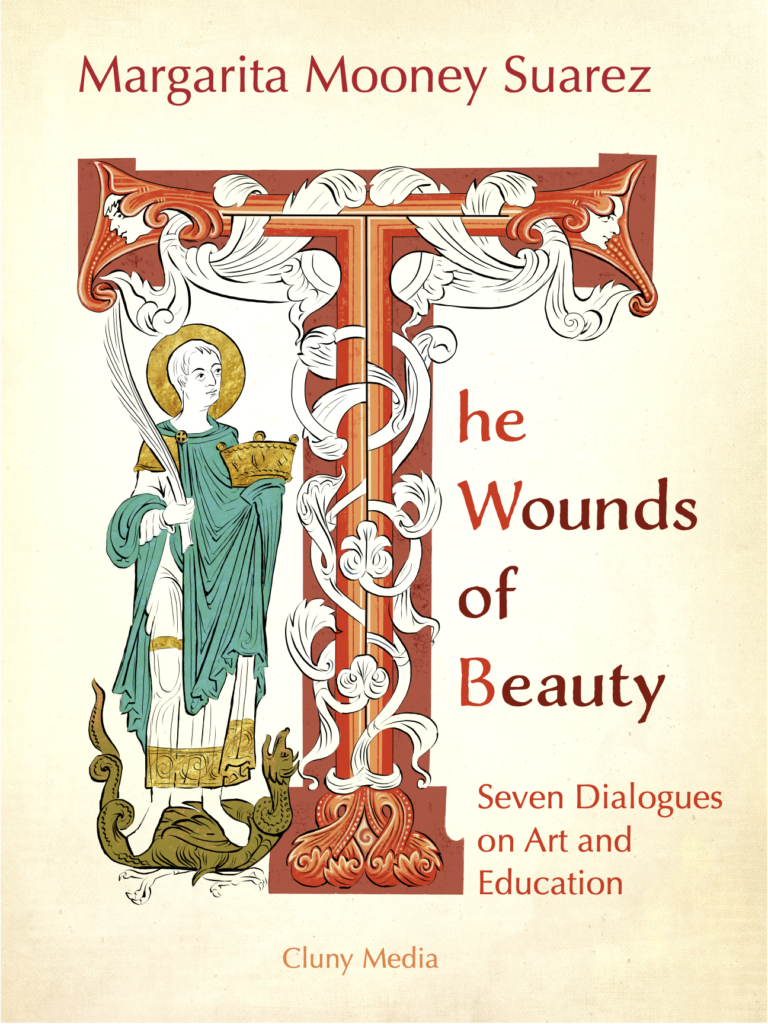FROM CLUNY MEDIA

Introduction: From A Crisis of Beauty to a Culture of Reverence
Humans learn from moral exemplars. We learn through stories. Beauty attracts us to the truth and inspires us to pursue wisdom. The Wounds of Beauty: Seven Dialogues on Art and Education shares the stories of seven renowned educators, culture-creators and thought leaders who have developed practical wisdom from their own life experiences and areas of expertise in education, creativity and culture.CS Lewis once wrote, “human life has always been lived on the edge of a precipice…[therefore] if men had postponed the search for knowledge and beauty until they were secure, the search would never have begun.” Lewis contends that even when faced with suffering, humans fill their lives with humor and art. The conversations in the book are urgent because misunderstandings about beauty have created a civic and often even a religious culture that is devoid of reverence. Without reverence, many people are incapable of experiencing lasting joy. In much of the modern university, all knowledge has been labeled as ideology. Without knowing how beauty connects to the glory of the truth, reason can become desiccated and joyless. Without beauty in places of worship, creative artists pursue their vocations apart from the eternal, furthering the divide between religious and secular culture.
Seven Life-Changing Encounters with Beauty and Wisdom
In the first chapter, Mooney Suarez and Peter Brown, Professor of History Emeritus at Princeton University explore convergences and differences between understandings of beauty in Platonic thought and among early Christian converts such as St. Augustine. Brown also shares how beauty shaped Christian civilization and monasticism—both East and West—in late antiquity.
In Chapter two, the poet and former director of the National Endowment of the Arts Dana Gioia joins Mooney Suarez to examine creative intuition in poetry and literature. Far from a relic of the past or a pastime for elites, Gioia forcefully argues for the importance of poetry and the arts more broadly as the foundation of a thriving public culture.
In the third chapter, Mooney Suarez has a conversation with poet and philosopher James Matthew Wilson about the strong claim that art has on how we should live. Contra the commonplace critical theory that dominates the humanities and increasingly all realms of inquiry, they discuss how beauty is connected to human happiness and to truth because beauty shows us the splendor of form of all creation.
In Chapter 4, Mooney Suarez dialogues with musicologist George Harne, Executive Dean of the School of Arts and Sciences at the University of St. Thomas – Houston. Although music is one of the four subjects of the quadrivium in the liberal arts, few people know why music is part of the human longing for beauty and its connection to other forms of knowledge, including mathematics.
Mooney Suarez’s discourse with Sister Noëlla Marcellino, OSB of the Benedictine Abbey of Regina Laudis explores how Sister Noëllawent from a college dropout, to joining a monastery, earning a Ph.D. in microbiology and becoming known as “The Cheese Nun.” This fifth chapter of the book dives into the Benedictine Way and its pattern of authentic living expressed in chant and cheesemaking.
Chapter 6 is a conversation with David Clayton, Catholic convert from atheism, iconographer and Provost of Pontifex University. Mooney Suarez and Clayton contemplate the role of art in creating educational curricula and communities. By pairing classical understandings of art like Vitruvius, Boethius, Bonaventure and Palladio—all of whom saw a connection between mathematics and art—with modern voices like Pope Benedict the XVI and Stratford Caldecott, this discussion explores the way of beauty as a path to human happiness, cultural renewal, and social order.
Sir Roger Scruton was one of the most important philosophers of recent decades; he gained notoriety for exposing various ways that Marxism and atheism influenced universities and public culture.Mooney Suarez invites Francis X. Maier, senior fellow at the Ethics and Public Policy Center and research scholar at the University of Notre Dame Center for Citizenship and the Constitution,for Chapter 7’s discussion. They reflect on the ideas that gave rise to meaninglessness and pessimism in education and culture. They suggest how we can better navigate the landmines in our current educational system in order to revitalize culture.
Readers of The Wounds of Beauty: Seven Dialogues on Art and Education will come away knowing how to lead others to the truth, encounter the sacred, live with joy, interpret culture, enter deeply into leisure, form a coherent identity, and build a common good where justice is both true and beautiful. Each chapter has discussion questions and suggests readings from key texts from authors as diverse as Plato, Aristotle, Augustine, Bonaventure, Jacques Maritain and Pope Benedict XVI. The book includes practical suggestions to incorporate beauty into education, places of worship, and our civic culture and contains discussion group guide for anyone who wants to restore purpose to their lives and our lives together.
From the art | Educating For Beauty & Wisdom | Education series
View more Posts